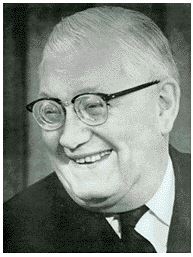
Year Born: 1894
Year Died: 1976
Pioneer
Thomson, Roy Herbert – Lord Thomson of Fleet (1894-1976)
His was a “rags to riches” story. Roy Thomson, Toronto-born son of a barber, worked his way through Business College; worked throughout World War I after being rejected by the Army because of his eyesight, (he had worn those “pebble” glasses since grade school), tried farming in Manitoba after the war, briefly; returned to Toronto to become a salesman, starting a distribution business with his brother, ending up as an agent for De Forest Crosley Radios in the only district left, Northern Ontario.
Thomson found it tough selling radios in an area where there were no radio stations, and only spotty reception on some nights from the high powered, clear channel stations in the U. S. After some months of this drudgery, he decided to put a station on the air himself. Finding that nearby Abitibi Paper Company had a licence they weren’t using, he made a deal to rent it for a year for $1.00 after which time they could ask to take it back. If they didn’t ask, the licence would then belong to Thomson outright.
He then visited the National Carbon Co. in Toronto and was able to purchase (for $200.00 plus several promissory notes, again with a similar “rider” on the notes), an old, unused transmitter along with the temporary use of a technician to install it. Thus, in March of 1931, CFCH North Bay went on the air.
Thomson continued to sell radios but he was now much more successful. And he started to make money at the radio station. North Bay was a railroad town. To the north, Timmins and Kirkland Lake were not affected by the Depression nearly as much as the rest of the country; since gold had been discovered, it was still boom town conditions. Thomson set his sights on Timmins and CKGB went on the air in 1932, followed by CJKL Kirkland Lake in 1933. These stations attracted some interesting staff members who went on to bigger careers, such names as Jack Kent Cooke, Jack Davidson and Tommy Darling, to name a few.
Downstairs in the building in Timmins that housed CKGB, was a printing press from a defunct newspaper. Thomson enquired of the owner if it was for sale, bought it on the same terms as the transmitter, and the former Timmins Citizen became The Press – Roy Thomson’s first newspaper. It started as a weekly, moved to twice a week and then in 1935 became a daily.
The CRBC, which now became the CBC, was getting tight with the granting of licences, particularly more than one to any individual. This caused Mr. Thomson to concentrate on newspapers, which did not require government licences. Along the way, he partnered with another newspaperman who wanted to get into radio and so in a joint venture with Rupert Davies, put CHEX Peterborough on the air in 1942, and CKWS Kingston started in 1943, Rupert Davies owning 51% and Thomson 49% plus the Management contract. Both these stations were granted Television licences in 1954.
From this base of broadcasting, Roy Thomson put all his earnings into acquiring newspapers around the world in a dozen countries and along the way, many magazines and printing companies. Thomson also owned a half a dozen radio stations outside Canada and a dozen Television stations, most notably Scottish Television based in Glasgow. It was at that time that he uttered the now-famous statement that having a commercial televlsion licence was like having “a licence to print money”. He is perhaps best known outside Canada for his purchase of The Scotsman published in Glasgow and The Sunday Times of London.
His Peerage was bestowed on him in 1963 – “Baron Thomson of Fleet”.
Roy Thomson died in London in August 1976.
Source: “Roy Thomson of Fleet Street” by Russell Brandon Collins – 1965
Written by Ross McCreath – April, 1997
